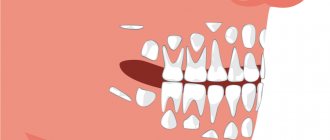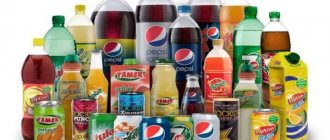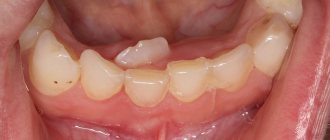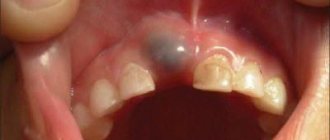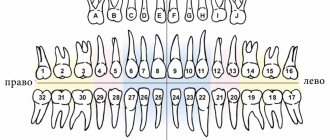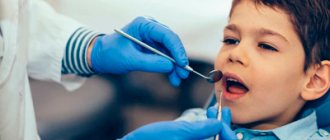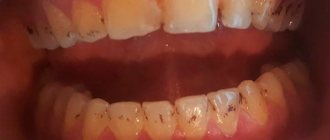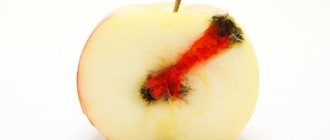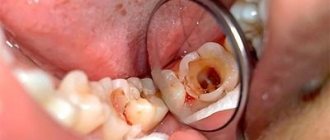Pulpitis is an inflammation of the internal structure of the tooth - the neurovascular bundle. In the vast majority of cases, this disease is caused by caries - many parents believe that it is not necessary to treat it, because baby teeth must be replaced quickly. However, this statement is incorrect, since caries, which is not addressed in time, causes tooth destruction and inflammation of the pulp.
Primary molars, especially the lower ones, are more susceptible to this. This is due to the relatively thinner enamel - the infectious process reaches the internal structures of the tooth faster. For the same reason, pulpitis in children develops much faster than in adults.
Among the causes of the disease are also injuries, including those associated with improper treatment of enamel caries, when the doctor accidentally exposes the pulp during tooth preparation.
Symptoms of pulpitis in children
Symptoms and treatment of pulpitis in children vary depending on the form and severity of the disease. Pulpitis has two forms - acute and chronic. The first is relatively less common, but the symptoms in this case are more pronounced. There are two stages of the inflammatory process:
- Serous. The pulp becomes inflamed, and the tooth canals are filled with serous fluid. The child experiences severe pain in the tooth, which intensifies at night or with exertion—chewing on the side of the causative tooth. Often there is only one episode of pain. Within a few hours, the inflammation moves into the next stage.
- Purulent. Purulent contents begin to form in the root canals of the tooth. The severity of this stage depends on several parameters: the state of the child’s immune system, the activity of microorganisms, the state of the root system of the tooth, and the age of the young patient. The pain can be tolerable if the child’s immunity functions normally, microorganisms multiply slowly, and pus escapes through the carious cavity of the tooth. However, more often there is quite pronounced pain, prolonged attacks, and the unpleasant sensations radiate to other teeth. They intensify with mechanical, temperature effects on the causative tooth; the child’s appetite worsens or he refuses food altogether. In rare cases, there is an increase in body temperature and enlarged lymph nodes.
It is worth noting that chronic pulpitis can be asymptomatic, and there are often cases of the development of an inflammatory process in a previously filled tooth. The fact is that it can be quite difficult to properly treat the carious cavity of a child’s tooth before filling it - this is due to the emotional state of the patient and the forced haste of the dentist. This leads to the fact that the filling is installed in a cavity that is not sterile or is not sufficiently dried from saliva - pathogenic microorganisms continue to multiply, penetrating deep into the tooth and causing pulpitis.
With chronic pulpitis, pain can only occur when food debris gets into the carious cavity. The gangrenous form of the disease is characterized by the appearance of pain some time after eating hot food, a feeling of fullness and heaviness in the tooth, and bad breath.
Acute pulpitis. Types and symptoms
Acute pulpitis in children is diagnosed very rarely. This is due to the fact that due to the structural features of milk teeth (in particular the root system), it very quickly becomes chronic. The acute form has the most pronounced symptoms, so it is important for parents not to miss the moment and, if characteristic symptoms are present, immediately take the child for examination to the dentist.
- Severe and sudden toothache, worse at night.
- Painful sensations when pressing, eating, exposure to cold and hot.
- Weakness, headache, fever.
- Swelling in the area of the diseased tooth.
- Enlarged lymph nodes.
- Purulent discharge (rarely observed).
According to the degree of spread, acute pulpitis of primary teeth is divided into focal and diffuse. In the first case, the disease affects only a small area of the pulp, in the second - both the coronal and root. It is almost impossible to detect pulpitis at the focal stage, since it covers the entire pulp of a baby tooth literally in a matter of hours. At an advanced stage, acute pulpitis can develop into two of the most dangerous forms.
- Serous pulpitis.
Occurs when serous fluid accumulates in the canals. - Purulent pulpitis.
It is a continuation of the serous stage. There is an accumulation of purulent exudate in the pulp chamber, which can result in the formation of an abscess. Purulent acute pulpitis in children is usually accompanied by aching pain (can be felt in other parts of the jaw and head), fever and swelling of the tissue in the affected area.
When should you visit a dentist?
The sensitivity of the neurovascular bundle of a tooth in a child is lower than in an adult, so the symptoms of its inflammation may be erased or absent altogether. It is important to contact a pediatric dentist when the first symptoms of caries appear - a dark spot on the tooth, or the child complains of pain. You should hurry up with your visit if:
- severe pain;
- increased pain when eating hot or cold food/drinks;
- bad breath;
- elevated body temperature;
- inflammation of the gums around the tooth;
- darkening of the enamel.
How to determine that a child has started pulpitis - forms of the disease and their symptoms.
- Acute pulpitis
Acute pulpitis can develop both with and without a carious cavity in the tooth. The disease begins acutely, most often in the evening or at night.
Symptoms of acute pulpitis in a child that require immediate contact with a dentist:
- Sudden severe toothache, often the child cannot indicate which tooth or even which side of the jaw hurts, but unknowingly, he will lie on the painful side.
- A sharp increase in pain from hot or warm food, drink, or cold brings temporary relief to the child.
- Increased pain when pressing on the tooth, chewing, clenching the jaws.
- Swelling of the gums, soft tissues of the face, enlargement of the submandibular and/or postauricular lymph nodes.
- Chronic pulpitis
Chronic pulpitis in children is hidden and almost asymptomatic; the diseased tooth has a carious cavity or filling. In more than half of the cases, surrounding tissues are involved in the process; very often there is a suspicion of periodontitis, so X-ray diagnostics are performed before treatment.
Symptoms of chronic pulpitis of primary teeth in children:
For fibrous pulpitis:
- Slight pain when chewing solid food. You may notice that there is more plaque on one side of the child's teeth because the child avoids chewing on the affected tooth.
- Pain from exposure to cold.
For gangrenous pulpitis:
- There is no pain, there may be a short-term reaction to hot food.
- “Delayed pain”, i.e. the reaction occurs after a certain period of time, after exposure to the stimulus.
- Discomfort in the tooth, the child complains that he is “different.”
- Sometimes there is a smell from a diseased tooth.
For chronic hypertrophic pulpitis.
This type of pulpitis is determined by the doctor at the appointment, after opening and examining the carious cavity, by excessive growth of pulp tissue.
Parents should be wary of:
- A severely damaged tooth with a large carious cavity.
- The child previously complained of tooth pain.
- Exacerbation of chronic pulpitis
The symptoms of exacerbation of chronic pulpitis are very similar to the symptoms of acute pulpitis, with the difference that:
- The diseased tooth has an open or filled carious cavity.
- The child had previously complained of toothache.
Pulpitis of a baby tooth: is it necessary to treat?
Treatment of pulpitis in children should be carried out in any case and as soon as possible. It is unacceptable to wait for a baby tooth to fall out, stopping only the symptoms. Failure to provide assistance to a child can result in serious complications - periostitis (in common parlance - gumboil), periodontitis - inflammation of the periodontal tissues. In addition, the infectious process in the neurovascular bundle of a baby tooth can spread to a permanent tooth when it erupts.
If a long time must pass before the eruption of a permanent tooth, premature destruction of a baby tooth due to pulpitis can lead to malocclusion - displacement of healthy teeth in a row, change in their position, which will require complex orthodontic treatment in the future.
If a baby tooth with pulpitis is soon to be replaced by a permanent one, the doctor may resort to extraction. In any case, this disease should not be ignored.
Why is pulpitis dangerous for a child?
If pulpitis is not treated in time, the inflammation very quickly turns into a purulent form, accompanied by general intoxication of the body. Inflammation spreads to periodontal tissue and complications arise.
Complications of pulpitis of baby teeth can be:
- General intoxication of the body. Its symptoms are fever, fever, weakness, headache, sleep disturbance, and refusal to eat.
- Enlargement of the submandibular and retrouricular lymph nodes (lymphadenitis).
- Transition of the disease into a chronic course.
- Formation of fistulas on the gums next to the diseased tooth.
- Periodontitis is inflammation of the tissues surrounding the tooth, holding the tooth in the socket; periostitis (flux) is purulent inflammation of the periosteum.
- Sepsis is blood poisoning.
Treatment methods for pulpitis
The tactics of a pediatric dentist depend on the condition of the child’s tooth and dental system, the severity of his condition, and whether there are concomitant diseases of the oral cavity. If the pulpitis is very severe and there is a risk of a threat to its health, the tooth must be removed. However, in the vast majority of cases, it is possible to keep the tooth permanent until its natural replacement, since removal can lead to disruption of the bite or the position of the remaining healthy teeth in the row.
Traditional treatment of dental pulpitis in a child consists of devital amputation of the pulp and is carried out in several visits. The stages of treatment of pulpitis in children are presented as follows:
- The doctor opens the tooth cavity, removes carious tissue, and applies a paste to devitalize the pulp. It is designed to “kill” the neurovascular bundle and eliminate pain. If the paste contains arsenic, it is used for a period of 1-2 days; if an arsenic-free product is used, it is used for at least 7 days.v
- The second visit involves placing a special mixture into the canals for tissue mummification - a resorcinol-formalin mixture is used.
- The third visit is to fill the diseased tooth.
This method is practiced much less frequently today, since there is a possibility that the infectious process will persist in unsealed tooth canals - mummification of the pulp involves its “drying out” and the formation of voids in which pathogenic bacteria continue to multiply.
The modern approach to the treatment of pulpitis of primary teeth in children is extirpation - complete removal of the inflamed pulp. This can be done with or without prior killing or devitalization of the pulp. In many cases, devitalization is more preferable, since it relieves the child of any unpleasant sensations during the removal of the neurovascular bundle.
After the tooth canals are freed from pulp and carefully processed, the doctor fills them with an anti-inflammatory paste - it tends to dissolve along with the roots during the natural change of teeth to permanent ones. For this purpose, zinc eugenol paste is often used. This method of treatment is comparatively more effective, and if the canals are treated with the utmost care, the infection will not reactivate. Other modern methods of treating pulpitis in children include vital amputation. It consists of preserving the viability of part of the pulp - the upper part of the nerve is removed under local anesthesia, and a medicine with an antibacterial and anti-inflammatory effect is applied to the remaining root pulp. The drug closes the lower part of the neurovascular bundle without affecting its viability, and the tooth is subsequently filled.
The difference between the pediatric form of pulpitis and the adult form
The main differences between pulpitis of primary teeth in children and permanent teeth are that:
- In temporary teeth, inflammatory processes occur much faster. Thus, pulp inflammation can become widespread within a few hours. This is due to the hyperergic types of reactions inherent in the child’s body, as well as the peculiarity of the blood supply to the pulp.
- In a shorter period of time, the carious process can lead to the development of inflammation in the neurovascular bundle. The reason lies in the larger pulp chamber, in the larger dentinal tubules through which the infection spreads faster, as well as in less mineralization.
- Pulpitis of a baby tooth is often asymptomatic and does not cause pain in children. A clear clinical picture is observed in permanent teeth. This is why chronic fibrous pulpitis is often encountered during the treatment of caries or during routine examinations in pediatric dentistry.
Treatment of pulpitis of teeth with unformed roots
The root system of a baby tooth is formed over a long period of time after eruption, so there are often situations when caries begins to form on a tooth whose roots have not yet closed the apex. This leads to some treatment difficulties:
- short roots and wide channels;
- the upper part of the root is the “growth” zone, injury to which is an obstacle to root formation;
- the likelihood of infection of the permanent tooth germ;
Treatment of pulpitis of teeth with immature roots in children requires special care. The doctor must carefully monitor that the filling material is not carried beyond the expansion of the root apex. It is worth noting that complete removal of the pulp and treatment of the canals is impossible - the optimal solution here is vital and devital extirpation. Pulp amputation may also be used. The biological method, which consists in preserving a viable pulp and relieving inflammation, is also practiced quite often. Its essence is to prepare the tooth, apply a medicinal paste with calcium hydroxide, after which the tooth is filled with temporary material. A few days later, if there are no complications and the unpleasant symptoms disappear, the doctor installs a permanent filling.
Reasons causing the development of pulpitis
The main reasons that contribute to the appearance of pulpitis in children include:
Infectious pulpitis (most often as a complication of caries);
Traumatic (with a fracture of the coronal part of the tooth, accompanied by opening of the pulp chamber);
Iatrogenic (provoked by the dentist) pulpitis. It is observed when the pulp is accidentally opened while using a drill or when the pulp overheats due to insufficient cooling of the hard tissues of the tooth.
How to prepare a child for treatment?
Treatment of pulpitis of primary teeth in children is a rather complex task, so it’s great if the child is already familiar with the dentist’s chair. The first visit should be preventative - to familiarize yourself with the office environment, the doctor, and the instruments.
Also, the task of parents is to psychologically prepare the child. Required:
- talk to your child about doctors in a positive way - tell them that the dentist treats teeth and makes sure they don’t hurt;
- play dentist with toys and other family members;
- avoid mentioning pain or unclear, scary terms;
- do not deceive the child - explain that dental treatment may not be very pleasant, but it will not last long and the tooth will no longer hurt;
- remain calm, act gently but confidently if the child resists treatment;
- choose a suitable time for visiting - it is better in the morning, when the baby is alert and active;
- take a toy with you to calm the child;
- give the doctor the opportunity to establish contact with the small patient - do not rush him;
- Do not scare the child under any circumstances, do not threaten, do not blackmail.
If the situation cannot be controlled completely, you will have to reschedule the appointment for another day. However, the disease should not be ignored - treatment of pulpitis of baby teeth in children must be carried out one way or another. In special cases, treatment under general anesthesia may be considered, but this should be discussed with your doctor.
Treatment of pulpitis: how to adjust a child
Pulpitis of baby teeth causes a lot of trouble for the baby. There is no need to aggravate the already difficult days of the child; parents should definitely prepare him for a visit to the dentist.
Talk to the baby. Explain that the doctor will treat tooth pulpitis carefully and the patient will not feel pain. It is important that the child does not associate going to the dentist with torture chambers. Choose a positive doctor whom you trust, and dental treatment will become an exciting attraction.
The main task of parents is not to let the disease take its course. Since chronic pulpitis of the baby tooth, which is most often seen in the photo, can lead to further spread of the inflammatory process and damage to the rudiments of permanent teeth.
And don’t forget that preventing trouble is always easier. Therefore, do not allow pulpitis. Ensure that your child brushes their teeth correctly and regularly using high-quality oral hygiene products. And be sure to visit your dentist regularly.
ASEPTA BABY toothpaste for babies from 0 to 3 years old will help you quickly teach your baby to brush their teeth. The soft gel carefully cares for your teeth, reliably protecting them from caries. And the sweet taste of tutti-frutti makes the procedure pleasant and tasty.
Possible complications of treatment of pulpitis in children
Child anxiety is the main difficulty faced by pediatric dentists. Due to the emotional state of the patient, the specialist has to rush or fails to perform the manipulation carefully, which may result in the following complications:
- the paste is not applied to the nerve - this leads to the fact that the pain does not subside, and the procedure must be repeated again;
- burn of the gums by the paste due to its close location to the tooth;
- bleeding when processing unformed roots;
- perforation of the root of a baby tooth;
- breakage of instruments in the root canal.
You can avoid possible complications or minimize the likelihood of problems arising by normalizing the child’s psychological state and contacting an experienced, qualified doctor.
Prevention of pulpitis in children
Treatment of pulpitis in permanent teeth in children, as well as their “predecessors” - baby teeth - is a rather complex procedure that may require several visits to the doctor. Preventing a disease is easier than treating it - all you need to do is pay attention to hygiene procedures and teach your child how to brush their teeth correctly from a very early age.
It is also important to monitor the child’s diet - strengthen the enamel with solid foods (carrots, apples, etc.), provide a balanced diet to saturate bone tissue with minerals. It is better to limit sweets and give only water at night. Prevention of caries is the basis for preventing its complications, including pulpitis.
Incidence of pulpitis
Many parents do not take their children to the dentist, believing that pulpitis cannot develop in a child at 2 years of age. Mothers think that if they do not give crumbs of sweets, caries will not affect the enamel. Unfortunately, they are wrong. Dental pulpitis can be overcome by a child aged 2, 3 and 5 years.
At 2 years of age, the anterior milk teeth of the crocus are affected by pulpitis;
From 3-4 years of age, children more often suffer from pulpitis of the back teeth. Often a 4-5 year old child comes to the dentist crying from pain in his molars. Surprisingly, such inflammations occur several times more often than pulpitis of the front teeth in children.
